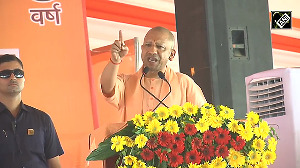Costing Rs 500 billion, the INS Vishal will be the Indian military's single most expensive defence platform.
Ajai Shukla reports.

Global shipbuilders and analysts were abuzz on Sunday, May 5, 2019, after the British media reported that New Delhi had approached London to buy the detailed blueprints for the Royal Navy's new aircraft carrier, HMS Queen Elizabeth.
According to the 'exclusive' report in the Mirror newspaper, the plans will be used to build the Indian Navy's second indigenous aircraft carrier (IAC-2), which is called INS Vishal.
In fact, INS Vishal has remained stalled since 2017, with India's ministry of defence declining to accord financial clearance.
The MoD believes the coming years's defence budgets cannot cater for the exorbitant cost of an aircraft carrier.
INS Vishal was conceived as a 65,000 tonne aircraft carrier, embarking 55 aircraft and costing Rs 60,000 crore (Rs 600 billion).
After the MoD objected to the cost, the navy downsized the proposal to a 50,000-tonne carrier costing about Rs 50,000 crore (Rs 500 million).
But the MoD remains unwilling to accord funding or sanction.
The Indian Navy has been talking to multiple prospective partners about providing design partnership for INS Vishal.
Besides the UK-headquartered BAE Systems and Thales, which built HMS Queen Elizabeth and are now working on a second carrier, HMS Prince of Wales; the Indian Navy also has a joint working group with the US Pentagon for designing an aircraft carrier.
In fact, the proposed design of INS Vishal bears a strong American signature, with advanced features like the 'electro-magnetic aircraft launch system' that exists only on the latest US aircraft carrier, the USS Gerald R Ford.
The navy believes that since the US navy is the acknowledged global leader in carrier-borne aviation, it would be the best possible partner.
However, in 2016, naval headquarters decided to go in for a conventionally powered aircraft carrier, rather than a nuclear-powered carrier like those US navy operates.
Since the HMS Queen Elizabeth is conventionally powered, the navy entered tentative talks with its builder, BAE Systems, for design consultancy on the propulsion system.
However, the Indian Navy has ruled out operating the F-35B Lightning II fighter, which the Royal Navy carriers embark.
Those 'short take off and vertical landing' aircraft are the most troubled variant of the joint strike fighter programme.
Therefore, the Indian Navy favours the F-35C 'catapult-assisted take off but arrested landing' variant, or the F/A-18E/F Super Hornet that currently equips US navy carriers.
That effectively amounts to an indigenous aircraft carrier with a conventional propulsion system similar to royal navy carriers, and an aviation complex based upon US navy carrier design.
However, all this remains on hold until the MoD clears the project.
Navy planners have pointed out that, while INS Vishal will indeed be the military's single most expensive defence platform, its Rs 50,000 crore cost would be spread over a ten-year design and construction period, amounting to an annual average of Rs 5,000 crore (Rs 50 billion).
They also point out that New Delhi's commitment to being the foremost navy in the Indian Ocean makes a third aircraft carrier is essential -- allowing the navy to operate one carrier each off the western and eastern seaboard, while a third is sequentially in refit and long maintenance.
Currently, the navy operates only a single carrier, the 44,000-tonne INS Vikramaditya bought from Russia.
Joining the fleet by 2021 will be the 40,000-tonne INS Vikrant, which is currently being completed at Cochin Shipyard.
Lobbying strenuously against clearing INS Vishal is the Indian Air Force, which wants to retain control of combat aviation assets.
Since World War II, when aircraft carriers came into their own, air forces the world over have considered carrier-borne aviation an encroachment on their turf.
Following this tradition, the IAF argues to the MoD that land-based fighters, operating from airfields along the coast in peninsular southern India, can project combat aviation power into the Indian Ocean.
This argument underlines the vulnerability of aircraft carriers to being sunk, a threat that bases ashore do not face.
"The outgoing government has put this on the back burner. But this will be one of the most pressing procurement decisions on the incoming government's plate," says a recently retired admiral.











 © 2025
© 2025